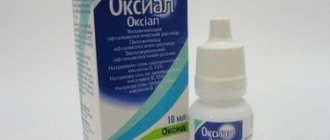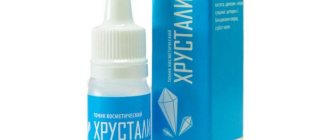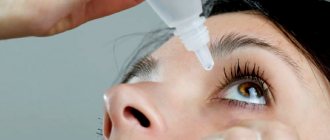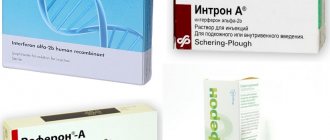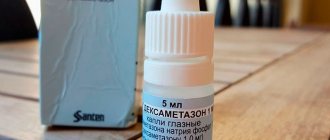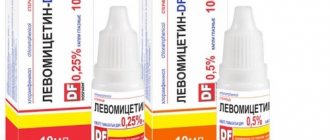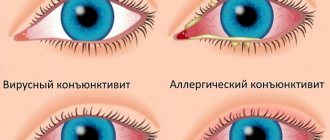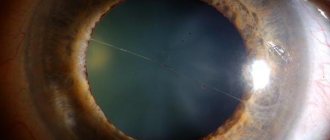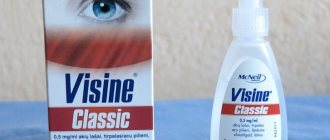How does the product work?
Ganfort eye drops are based on 2 active ingredients (bimatoprost, timolol maleate) that complement each other and create a therapeutic effect for patients with glaucoma. They allow you to more quickly stabilize intraocular pressure and stop the decline in visual acuity.
Bimatoprost is a fairly strong component for the treatment of glaucoma and eyelash hypotrichosis (weak eyelash growth). It quickly penetrates the mucous membranes of the eyes, the therapeutic effect (i.e., a decrease in intraocular pressure) occurs within 4 hours, the maximum result from use is noticeable in patients after 8-12 hours and persists throughout the day.
Among the advantages of bimatoprost is the absence of side effects from the cardiovascular system; in particular, this component does not cause an increase in blood pressure and heart rate. The effect of the substance on eyelashes has not been fully studied, but in patients the number of eyelashes and the phase of their growth increase, and this allows the use of bimatoprost in cosmetics.
The second important component of Ganfort eye drops is timolol maleate. This substance is also successfully used in ophthalmology to reduce intraocular pressure (IOP) by reducing the amount of intraocular fluid produced. Compared to bimatoprost, timolol acts more quickly - intraocular pressure begins to fall within 20 minutes after instillation; in general, the substance is active for 8-24 hours.
Both bimatoprost and the second component timolol are used as separate agents for the treatment of glaucoma. Their combination in the drug Ganfort has its own advantages - it allows you to help patients with open-angle glaucoma and intraocular hypertension, if the use of mono drugs does not have the desired effect.
Ganfort
Description
Ganfort is a combination drug that contains bimatoprost and timolol maleate, which reduce high intraocular pressure (IOP) due to their combined action, which makes it possible to achieve a more pronounced effect compared to the effect of each drug separately. Bimatoprost is an ophthalmic agent that reduces IOP, belongs to the group of synthetic prostamids, and according to its chemical structure it is related to prostaglandin F2alpha (PGF2alpha), bimatoprost does not affect any of the known types of prostaglandin receptors. The mechanism of reduction of IOP by bimatoprost includes increased outflow of intraocular fluid through the trabecular nasolacrimal ducts and from the uveoscleral parts of the eye. Timolol is a non-selective beta-adrenergic receptor blocker, without intrinsic sympathomimetic and membrane-stabilizing activity. Timolol reduces IOP by reducing the production of intraocular fluid. The exact mechanism of action of timolol has not been established; it may be associated with inhibition of cAMP synthesis and caused by endogenous stimulation of β-adrenergic receptors. Pharmacokinetics. Systemic absorption of the drug is minimal and does not differ either with combined treatment or when taking each of the components of the drug separately. In two studies lasting 12 months, during which the absorption of the drug was studied, there was no systemic accumulation of any of the active substances. Bimatoprost In in vitro studies, bimatoprost penetrates the iris and sclera. When instilled with bimatoprost eye drops, the overall systemic effect is very low, with no accumulation effect. When instilling 0.03% bimatoprost solution, 1 drop into both eyes 1 time per day for 2 weeks, the Cmax of bimatoprost in the blood plasma was achieved within 10 minutes after application, and within 1.5 hours its concentration in the blood plasma decreased below the detection level (0.025 ng/ml). The mean Cmax and AUC values of bimatoprost were similar on the 7th and 14th days of use and were 0.08 and 0.09 ng h/ml, respectively, indicating that the equilibrium concentration of bimatoprost was achieved during the 1st week of topical use . Bimatoprost is moderately distributed in tissues, and the volume of systemic distribution when the drug reached equilibrium concentration was 0.67 l/kg. Bimatoprost is found predominantly in blood plasma. The binding of bimatoprost to plasma proteins is about 88%. Bimatoprost undergoes oxidation, N-diethylation and glucuronidation to form various metabolites. Bimatoprost is excreted primarily by the kidneys. About 67% of the drug administered intravenously to healthy volunteers was excreted in the urine, and 25% was excreted through the digestive tract. T? bimatoprost, determined after its intravenous administration, was about 45 minutes, and the total clearance was 1.5 l/h/kg. Timolol In patients undergoing cataract surgery, after instillation of eye drops in the form of a 0.5% solution, the peak concentration of timolol in the intraocular fluid after 1 hour was 898 ng/ml. A certain amount of the drug enters the systemic circulation and is metabolized in the liver. T? timolol is about 4–6 hours. Part of timolol, which has been metabolized in the liver, is excreted through the digestive tract, and the other part and metabolites are excreted by the kidneys. Timolol is slightly bound to plasma proteins.
Features of using Ganfort drops
The instructions for using Ganfort drops indicate that the Irish manufacturer of the drug has, as a result of research, proven that the use of Ganfort drops once a day stabilizes IOP as effectively as therapy with bimatoprost (1 r.v. day) and timolol (2 r. a day). day). To achieve best results, the manufacturer recommends:
- Use Ganfort 1 drop 1 time per day (can be in the morning or evening, but preferably at the same time);
- If the patient forgot to apply eye drops, the product must be used the next day, but it is strictly forbidden to exceed the number of instillations;
- To reduce systemic absorption, after instillation it is advisable to press the lower eyelid in the nose area with your fingers for 1 minute;
- The drug should be used very carefully by patients with inflammatory diseases of the organ of vision and other eye ailments;
- For patients who wear soft contact lenses, to instill the drug, they need to remove them, wait 15 minutes and only then put them on again;
- If the patient has been prescribed several ophthalmic drugs, a 15-minute break should be taken before instillation of each drug. Eye gels or ointments are used last;
- You should not use Ganfort drops for eyelash growth without other medical indications, since other products containing bimatoprost can be used to treat this cosmetic problem;
- To preserve the cleanliness of the bottle and the integrity of the eye, the drug must be instilled carefully, without poking the eye.
Ganfort drops are produced in 3 ml dropper bottles (see Ganfort photo). After opening, the product is suitable for 28 days.
special instructions
Before starting therapy, the patient must be warned about the increased intensity of eyelash growth, increased pigmentation of the skin of the eyelids, and the iris. These changes may be permanent, resulting in differences between the eyes. After administration of eye drops, a transient decrease in visual acuity may occur. Therefore, experts advise not to operate complex mechanisms until the patient’s condition is completely normalized.
The drug contains benzalkonium chloride, which leads to irritation of the mucous membranes of the eyes and discoloration of soft contact lenses. Therefore, ophthalmic devices must be removed before instillation; they should be put on again after 15 minutes.
In order to reduce the risk of microbial contamination, it is necessary to prevent any contact of the tip of the dropper bottle with foreign objects and tissues of the eye.
After opening the bottle for the first time, eye drops must be used within 28 days. After this time, the drug must be disposed of.
Contraindications and side effects: how not to cause harm?
Since Ganfort drops consist of two active components, side effects from using the product can be caused by each of them. Among the main adverse reactions to substances, the most often diagnosed are:
- Pigmentation of the eyelids;
- Conjunctival hyperemia – the eye becomes red and swollen;
- Superficial keratitis - can manifest itself both as external defects and more complex consequences;
- Corneal erosion - to improve the condition, the prescription of restorative drops is required;
- Foreign body sensation;
- Dizziness, headache.
All these side effects occur quite often, approximately in every 100 patients. Other consequences, including rhinitis, bronchospasm, shortness of breath, eyelid pain and eye fatigue, are diagnosed less frequently.
Some patients experience a reaction not to the main active ingredients, but to an additional substance in Ganfort drops - the preservative benzalkonium chloride.
Its effects may cause the development of punctate keratopathy and/or toxic ulcerative keratopathy, which makes the drug unsuitable for the treatment of patients with damaged corneas or excessive dry eyes. Then ophthalmologists recommend using monodoses for the treatment of Ganfort - they contain active ingredients, but there are no preservatives in their composition.
To prevent the prescription of the drug from causing complications of concomitant diseases in the patient, Ganfort should not be used:
- If hypersensitivity to bimatoprost, timolol and excipients of drops is diagnosed;
- Patients with acute and chronic diseases of the respiratory system, especially bronchial asthma and obstructive bronchopulmonary diseases;
- Patients with sick sinus syndrome, sinus bradycardia, sinoarticular block, heart failure and other serious diseases of the heart and blood vessels;
- Children under 18 years of age - due to insufficient research data;
- Pregnant and lactating women - only in case of urgent need. There are no data on the use of Ganfort for this category of patients.
The drug does not have a pronounced effect on the speed and accuracy of driving vehicles and mechanisms, but since after instilling the drug the patient may experience fogging for some time, you should wait 15-20 minutes and only then perform important work.
How Ganfort interacts with other products, price and analogues
Ganfort eye drops, although they do not have much systemic absorption, together with other drugs that have a direct or indirect effect on the functioning of the cardiovascular system, should only be prescribed by a specialist. The drug is used especially carefully and carefully in combination with the following groups of pharmaceuticals:
- β-adrenergic receptor blockers;
- Antihypertensive/cardiac glycosides;
- Mydriatic substances;
- CYP 2D6 inhibitors.
The price in pharmacies for the drug Ganfort is in the range of 900-950 rubles, while at the same time, the drug in monodoses of Ganfort in disposable containers No. 30 costs more than 1000 rubles.
If there is a need to select Russian analogues of Ganfort, you can opt for Timolol-MEZ - the product does not contain bimatoprost and has a therapeutic effect due to the active ingredient timolol. The drug is inexpensive and cannot completely replace Ganfort.
The antiglaucoma combination drug Dorzolamide + Timolol from Solopharm is also available for order. In general, there are no complete analogues of Ganfort on the market, but in pharmacies you can choose other drugs for the treatment of glaucoma, including:
- Arutimol - drops are produced with different concentrations of timolol. This allows you to more accurately select the required dose for patients with ocular hypertension and open-angle glaucoma. The price of the product is much lower than Ganfort drops;
- Cosopt - a product from a French manufacturer has a combined composition. The active ingredients are dorzolamide hydrochloride and timolol maleate. The principle of action, side effects and contraindications are very similar to Ganfort drops;
- Okumed is an inexpensive Indian drug based on timolol;
- Bimoptik - drops based on bimatoprost, produced in Romania. There is no other active ingredient (timolol) in the composition;
- Ovtan Timolol - French drops that contain timolol maleate. They are prescribed to patients with open-angle, secondary glaucoma and to reduce IOP.
Reviews
Despite the fact that the main effect of the drug is to combat IOP, you can mostly find Ganfort reviews for eyelashes on the Internet. This is due not so much to the rare prescription of the drug for the treatment of glaucoma, but to the small number of available drugs based on bimatoprost for the treatment of eyelash hypotrichosis.
Ekaterina, 25 years old, Kazan. A friend advised me to use Ganfort for eyelash growth. Her eyelashes have really become thick and long. The drug gave me dark spots on my eyelids and a strange feeling of sand in my eyes. In short, I stopped using the product after a week.
Marina, 29 years old, Chelyabinsk. After eyelash extensions, my eyelashes became thin and sparse. I found reviews on the Internet about the use of Ganfort. I was afraid to drip this remedy on my own, and turned to an ophthalmologist. She said that if you carefully instill the product for a month, side effects will be minimal. Ganfort really helped me.
Victoria, 54 years old, Omsk. Before being prescribed Ganfort, I had several types of drops for glaucoma. Some caused me a terrible burning sensation, others stopped working after 2 months of use and my vision deteriorated significantly. During my last visit to the ophthalmologist, the doctor prescribed Ganfort for me. The product is quite expensive - the package lasts for a month, but I am satisfied with the result.
Strengthening our eyelashes
Professional cosmetologists, of course, could not ignore the problem of eyelash growth, which is why many products of various structures and consistencies were invented to help women.
It is interesting that their discovery in this particular form occurs during the experiments of medical scientists developing an effective medicine for the treatment of eye diseases. As the experiments progress, it turns out that they are able to influence the growth and strengthening of the hairs surrounding the eyes. Such discoveries are immediately adopted by cosmetics manufacturers.
The composition of the mentioned products, as a rule, includes natural components with the addition of necessary chemicals, acids, and in some cases hormones.
Products for improving eyelash growth are available in the form of:
- balms;
- serums;
- gels;
- carcasses;
- boosters (the same serums, concentrates);
- ointments;
- nicotinic acid;
- air conditioners;
- oils;
- emulsions.
Advertising on TV never tires of introducing a wide variety of drugs, promising quick and amazing results in increasing eyelash growth. The names of the products and the companies that produce them change each other. It is very difficult not to get lost in this sea of information.
Eye drops
Latisse
Latisse eye drops were created in India to treat glaucoma. They contain hormones and have a side effect - during treatment, patients' eyelashes began to grow rapidly, and they were so thick and long that they gave the impression of false ones. Soon the company will produce a drug for eyelash growth.
However, side effects have been discovered when using Latisse: the eyes often become inflamed, the skin on the eyelids darkens, and sometimes the iris of the eyes becomes darker.
Therefore, prior consultation with an ophthalmologist is required before use.
Careprost
A similar story happened at one time with the now quite popular Indian Careprost Bimatoprost Ophthalmic Solution. It can be used not at all for its intended purpose, namely as an activator, and at the same time - in the case of high intraocular pressure - as a medicine.
A gel with the same name is applied to the eyelash growth line for two months. This product has also been successfully used to restore hair follicles after eyelash extensions have been removed.
Travatan
The basis of all eyelash care products is prostaglandin. It is also included in the composition of the American eye drops “Travatan” designed to combat glaucoma, which, thanks to this, can also act as a stimulator of eyelash growth and increase their volume.
Ganfort
From the same series is Ganfort, which lowers eye pressure. Its use has the side effect of causing eyelashes to grow and become stronger.
Taurine
Vitamin eye drops “Taurine” also play a similar role. At the same time, they can relieve inflammation caused by improper eyelash growth.
Queen Lash
Queen Lash also has a similar effect, but you can’t use it as a medicine. Manufacturers claim that this even more effective remedy takes all the best from Careprost. It not only regenerates damaged cells, but also lays new bulbs, which means that the eyelashes will become thicker. You can put Dreamlash in the same row.
Air conditioners
Advanced Lash
Produced by a very large American company, Advanced Lash conditioner is famous for its quick, amazing results. It has already been rated by many stars, but not everyone can afford the price. Thanks to the presence of bioleptides in the product, eyelash hairs are made silky and elastic, and they are strengthened with the help of biotin, panthenol, extracts of ginkgo biloba leaves and the “root of life” - ginseng.
It is recommended to use the conditioner after removing all makeup from the face before going to bed - once a day, applying along the edge of the eyelash growth.
MD Lash Factor
A professional conditioner, and quite expensive, is MD Lash Factor TM Eyelash. Its application is not particularly special - it is applied like eyeliner at the roots of the eyelashes.
Serums
Almea Ixlash
Almea Xlash eyelash growth serum consists of 100% natural ingredients that are powerful natural antioxidants and immunostimulants. They know how to resist age-related changes, and with their help, new tissues accelerate their growth.
This product is used at night, and after a month significant changes in the “appearance” of the eyelashes become noticeable.
